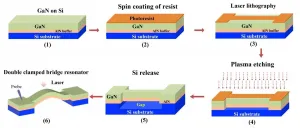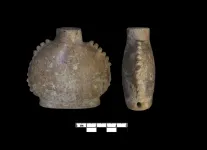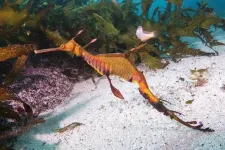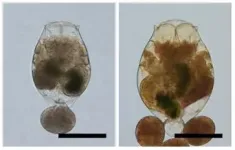Dual-shot dynamics and ultimate frequency of all-optical magnetic recording on GdFeCo
2021-01-15
(Press-News.org) The development of ultrafast all-optical switches has long been a popular topic in photonics, while the speed of magnetization reversal triggered by means other than magnetic fields has recently attracted intense interest in spintronics. The discovery of all-optical helicity-dependent switching in metallic GdFeCo has promised a merger of the fields of photonics and spintronics, paving the way for faster and more energy-efficient information processing technologies. However, the real potential of all-optical switching is still poorly understood because it is still unclear whether magnetic switching by light can keep up with the GHz frequencies required by photonics technologies. Another serious obstacle is the skepticism regarding the scalability of all-optical magnetic switching down to the sizes of spintronic devices, which are well below the diffraction limit.
In a new paper published in Light: Science & Applications, a team of scientists, led by Professor Xiangping Li at Jinan University in China and Professor Alexey V. Kimel at Radboud University in The Netherlands have proposed a dual-shot opto-magnetic switching method and studied its dynamics through a time-resolved magneto-optical imaging system. They experimentally unveiled the ultimate frequency of repetitive all-optical magnetization reversal through time-resolved studies of the dual-shot magnetization dynamics in Gd27Fe63.87Co9.13. Varying the intensities of the shots and the shot-to-shot separation, they revealed the conditions for ultrafast writing and the fastest possible restoration of magnetic bits. It is shown that although magnetic writing launched by the first shot is completed after 100 ps, a reliable rewriting of the bit by the second shot requires separating the shots by at least 300 ps. Using two shots partially overlapping in space and minimally separated by 300 ps, they demonstrated an approach for GHz magnetic writing that can be scaled down to sizes below the diffraction limit.
These scientists forecast: "Our findings demonstrate the potential of all-optical magnetic writing with a repetition rate of up to 3 GHz and a spatial resolution below the diffraction limit, which fills a knowledge gap and completes missing technology to promote its widespread applicability in the next revolution of information processing. The advanced features observed in this work may favour the realization of spatially and temporally confined magnetization control through light and greatly promote the development of ultrafast and highly compact devices at the intersection of photonics and spintronics."
INFORMATION:
[Attachments] See images for this press release:

ELSE PRESS RELEASES FROM THIS DATE:
2021-01-15
"The lotus roots may break, but the fiber remains joined" is an old Chinese saying that reflects the unique structure and mechanical properties of the lotus fiber. The outstanding mechanical properties of lotus fibers can be attributed to their unique spiral structure, which provides an attractive model for biomimetic design of artificial fibers.
In a new study published in Nano Letters, a team led by Prof. YU Shuhong from the University of Science and Technology of China (USTC) of the Chinese Academy of Sciences (CAS) reported a bio-inspired lotus-fiber-mimetic spiral structure bacterial cellulose (BC) hydrogel fiber with high strength, ...
2021-01-15
Liwen Sang, independent scientist at International Center for Materials Nanoarchitectonics, National Institute for Materials Science (also JST PRESTO researcher) developed a MEMS resonator that stably operates even under high temperatures by regulating the strain caused by the heat from gallium nitride (GaN).
High-precision synchronization is required for the fifth generation mobile communication system (5G) with a high speed and large capacity. To that end, a high-performance frequency reference oscillator which can balance the temporal stability and temporal resolution is necessary as a timing device to generate signals ...
2021-01-15
PULLMAN, Wash. - Scientists have identified the presence of a non-tobacco plant in ancient Maya drug containers for the first time.
The Washington State University researchers detected Mexican marigold (Tagetes lucida) in residues taken from 14 miniature Maya ceramic vessels.
Originally buried more than 1,000 years ago on Mexico's Yucatán peninsula, the vessels also contain chemical traces present in two types of dried and cured tobacco, Nicotiana tabacum and N. rustica. The research team, led by anthropology postdoc Mario Zimmermann, thinks the Mexican marigold was mixed with the tobacco to make smoking more enjoyable.
The discovery of the vessels' contents paints a clearer picture of ancient Maya drug use practices. The research, which was published ...
2021-01-15
Partially protected areas - marine reserves that allow some forms of fishing - are no more effective socially or ecologically than open marine areas in Australia's Great Southern Reef, a new UNSW study has concluded.
The research, published in Conservation Biology today, comes at a time when the High Ambition Coalition of 50 countries of the world (which does not include Australia) have pledged to protect more than 30 per cent of the planet's lands and seas by the end of this decade. But not all protected areas are created equal.
The UNSW study discovered partially protected areas in southern Australia had no more fish, invertebrates or algae and no difference in ...
2021-01-15
Researchers from Kumamoto University (Japan) have found an Edo period document that clearly indicates the Hosokawa clan, rulers of the Kokura Domain (modern-day Fukuoka Prefecture), completely stopped producing wine in 1632, the year before the shogunate ordered them to move to the Higo Domain (now Kumamoto Prefecture). The researchers believe that the discontinuation of wine production was directly related to this move and because it was considered to be a drink of a religion that was harshly suppressed in Japan at that time, Christianity.
Previous analysis of historical documents revealed that the lord of the Hosokawa clan, Tadatoshi Hosokawa, ordered wine production from 1627 to 1630 for medicinal use. His ...
2021-01-15
Divergences between scientific and Indigenous and Local Knowledge can provide a better understanding of why local pastoralists may be willing, or not, to participate in conservation initiatives for carnivores, a study from University of Helsinki suggests.
Carnivore conservation has historically been based primarily on scientific knowledge using a wide range of sampling methods, such as camera trapping and track surveys. However, the estimates of these common ecological sampling methods can be quite uncertain and can depend on accessibility and geology, which is the case of many remote areas, such as Sibiloi National Park in Northern Kenya. For this reason, the inclusion of local communities that share ...
2021-01-15
A research team led by scientists at the RIKEN Nishina Center for Accelerator-Based Science (RNC) has successfully created larger-than-usual strains of zooplankton -- which are used in fish nurseries -- by creating mutations with a heavy ion beam. The new strains of zooplankton could contribute to improving the survival rate and optimizing the growth of juvenile fish in aquaculture.
Economically important fish species, such as bluefin tuna, yellowtail, flatfish and groupers, are fed live bait until they are large enough to be fed with artificial foods. ...
2021-01-15
Any building project requires the formulation of a series of initial plans prior to starting construction to serve as a basis and guide for the whole process. A similar procedure is followed in software development, with the inclusion of a specific step known as modelling. "The process is equivalent to the production of a set of plans for a building before its construction," explained Universitat Oberta de Catalunya (UOC) Faculty of Computer Science, Multimedia and Telecommunications professor and member of the SOM Research Lab research group -from the Internet Interdisciplinary Institute (IN3)-, Robert Clarisó.
Engineers use modelling to describe ...
2021-01-15
In the last decades, Artificial Intelligence has shown to be very good at achieving exceptional goals in several fields. Chess is one of them: in 1996, for the first time, the computer Deep Blue beat a human player, chess champion Garry Kasparov. A new piece of research shows now that the brain strategy for storing memories may lead to imperfect memories, but in turn, allows it to store more memories, and with less hassle than AI. The new study, carried out by SISSA scientists in collaboration with Kavli Institute for Systems Neuroscience & Centre for Neural Computation, Trondheim, Norway, has just been published in Physical Review Letters.
Neural networks, real or artificial, learn by tweaking the connections ...
2021-01-15
An innovative new study is set to examine if changing our mealtimes to earlier or later in the day could reduce the risk of developing Type 2 diabetes.
Led by Dr Denise Robertson, Professor Jonathan Johnston and post graduate researcher Shantel Lynch from the University of Surrey, the study, outlined in the journal Nutrition Bulletin, will investigate if changing the time we eat during the day could reduce risk factors such as obesity and cholesterol levels that are typically associated with the development of Type 2 diabetes. The team of researchers will also for the first time investigate, via a series of interviews with participants and their friends and family, the impact of such changes on home life, work/social commitments and whether co-habitants of those who make such ...
LAST 30 PRESS RELEASES:
[Press-News.org] Dual-shot dynamics and ultimate frequency of all-optical magnetic recording on GdFeCo







